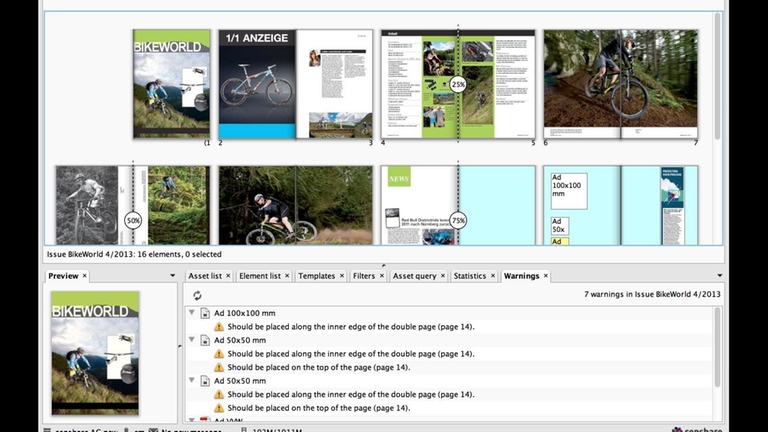Errors in page planning, as in the placing of ads, can be very unpleasant. In censhare 4.8, such problems can be quickly solved. Here, a window summarizes all the warnings and contains links to the questionable elements. By way of XSLT, companies can customize the existing placing rules.
Ensuring accurate page planning
Page planning is at the core of every publication process. Here, the edition will be honed up to the last minute. In this hectic process it is not always easy to take all the requirements into account. One ad is meant to appear in the first quarter of an issue, or another only on an odd page. Canceled ads must be removed. Doubly placed articles are not allowed. In response to this situation, censhare 4.8 supports users with an enhanced test tool in order to check conformity with guidelines and to process the warnings. After all, the later an error is recognized the higher the ensuing costs may be.
A window concisely summarizes the correction of all warnings. It lists all errors with a clear description for every affected object. One click on an entry highlights the corresponding element in the planning overview and the associated object (asset) in the asset list. There is no need for lengthy searches, especially with larger editions. From here, problems can be solved quickly.
With the help of XSLT a company can extend the pre-existing rules in censhare. It additionally produces individual rules for placing ads, articles, images or text. For example, XSLT can be used to define: full page ads should not be placed over a layout. An ad in a smaller format is permitted.
Users launch the checking process for the rules with a mouse-click.
Customer benefits
- Continuous checking for adherence to all rules defined for placement in page planning
- Avoidance of faulty placements first showing up in the time-critical phase before the print deadline
- Avoidance of additional costs caused by late discovery of errors in placement
- Clear presentation of warnings in a window with links to the affected objects
- One click to check all the rules
Application case
- Ensuring that an ad appears in the area of the issue agreed with the client
- Ensuring that an ad appears in the page position agreed with the client
- Defining specific rules, such as no placement of full-page ads on layout pages
- Recognition of content errors like the placement of coupons on the front and back page
- Recognition of deleted objects. This may happen if an ad which has already been placed is canceled in the booking system
Everything at a glance
With version 4.8 censhare displays all the warnings on placements in page planning clearly in a tab. censhare also checks for typical errors with object placement in page planning. These are overlapping objects or multiple placements of objects like ads or articles. This also includes deleted objects perhaps from the cancelation of an ad or coupons on the front and back pages. In addition, the placement rules for an object may be defined. For example, the fact that it should be placed on the right of an uneven page. Rules individually defined with XSLT are automatically enforced by censhare with all the others.
With version 4.8 censhare displays all the warnings on placements in page planning clearly in a tab. censhare also checks for typical errors with object placement in page planning. These are overlapping objects or multiple placements of objects like ads or articles. This also includes deleted objects perhaps from the cancelation of an ad or coupons on the front and back pages. In addition, the placement rules for an object may be defined. For example, the fact that it should be placed on the right of an uneven page. Rules individually defined with XSLT are automatically enforced by censhare with all the others.
Extension of the rules with XSLT
censhare stores XSLT rules for placements as assets with their own type. The system always executes these when users initiate a placement check.
censhare 4.8 is supplied with a standard set of example rules for XSLT. This set can be taken as a template and adjusted appropriately for other checks. censhare or its partners would be glad to help with this. The input for an XSLT rule is the XML of the issue. The result returned by the rule is XML with the suspect asset element and the reasons for this.




